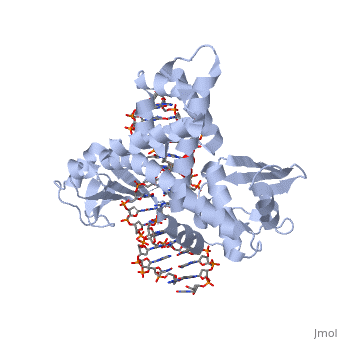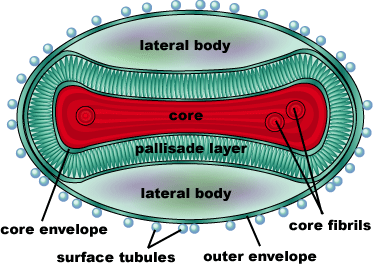User:Wade Cook/Sandbox 1
From Proteopedia
Smallpox (Variola Virus) - Topoisomerase 1B
FunctionThe smallpox virus invades host cells by binding to specific receptors on the host cell membrane. The virus binds to host cell receptors via hemagglutinin antigens expressed on its outer surface. The exact mechanism of entry is not yet known. Upon invasion of a host cell, the smallpox virus replicates in the host cytoplasm, rather than the host nucleus, using many of it’s own enzymes to replicate. Replication begins once the virion has reached the cytoplasm of the host cell. First, a messenger RNA molecule is transcribed by RNA polymerase and related enzymes before the genome is uncoated. The first genes that are transcribed, known as early genes, code for proteins that facilitate the uncoating of the viral genome and initiate a second round of transcription of intermediate genes. The intermediate genes produce mRNA which are translated into proteins that allow the transcription of the late class of genes. The late class genes encode proteins which make up the structural and enzymatic components of a new virion. Further replication of this virus leads to the eventual shutdown of the host cell’s DNA, RNA, and protein synthesis, and causes changes to the cell’s architecture to allow the virus to use the host cell’s genetic machinery for reproduction. One characteristic that makes the Variola virus so deadly is that it doesn’t require the host cell’s genetic machinery to begin replication. The reason for this is that the Variola virus codes for all the enzymes needed for its proliferation. One enzyme in particular, the type IB topoisomerase is responsible for unwinding the packaged, supercoiled, viral DNA to initiate viral replication. This is accomplished through a nick-joining mechanism of the double stranded DNA, in which a tyrosine nucleophile attacks a phosphodiester bond to form a 3’ phosphotyrosine linkage and releases a free 5’ hydroxyl group. This creates a nick to unwind supercoiling, which is then re-ligated to form relaxed DNA. Type IB topoisomerase is a key target for research against the spread of smallpox because it is integral for the viruses replication process. The replication of smallpox is complicated since it doesn’t hijack the host’s genetic machinery to reproduce, this makes the disease highly virulent, and hard to specifically target for elimination by antiviral drugs. DiseaseRelevanceSmallpox is a highly contagious disease, which accounts for its massive epidemics killing millions around the world. Although smallpox was declared eradicated by the WHO in 1980, there has been recent public concern about the use of smallpox as a biological weapon. This represents a serious threat to civilian populations, which stresses the importance of understanding molecular dynamics, mechanism and, risk, in order to prevent and control it in case of an outbreak. Structural highlightsSmallpox is caused by the Variola virus, a member of the genus Orthopoxvirus. It’s genome consists of a single, linear double-stranded DNA molecule made up of 186,102 base pairs. There are 10 enzymes that regulate gene expression, as well as about 100 nucleoproteins involved in transcription of the DNA. The DNA and nucleoproteins are held within a biconcave (dumbbell-shaped) core with two lateral bodies on either side. The function of the lateral bodies is unknown. The outer surface of the variola virus consists of lipids and proteins that surround this core. The variola virus consists of 90% protein, 5% lipid, and 3% DNA. This is a sample scene created with SAT to by Group, and another to make of the protein. You can make your own scenes on SAT starting from scratch or loading and editing one of these sample scenes.
| ||||||||||||


